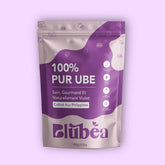What is Ube? Origin, taste and differences from other tubers
Discover ube, the Philippine purple yam with its unique vanilla-nutty flavor. Its origins, benefits, and differences from taro and sweet potato.
Ube: The Purple Jewel of the Philippines
Ube (pronounced “oubé”) is a tuber native to the Philippines, where it holds a central place in culinary culture. Recognizable by its deep purple flesh, it has been used for centuries in desserts, drinks, and festive dishes. Long a secret in Europe, ube is now winning over coffee shops and chefs around the world thanks to its spectacular color and deliciously fragrant taste.
What does ube taste like?
The taste of ube is unique and difficult to compare directly. We find:
-
sweet and vanilla notes,
-
an impression of toasted hazelnut and almond ,
-
a creamy texture, close to a pastry cream when cooked.
Unlike other tubers, its flavor is naturally rich without being overly sweet. It is this flavor profile that explains its success in lattes, ice creams and cakes .
Ube vs Taro vs Purple Sweet Potato: What are the differences?
It's common to confuse ube with other colorful roots. However, their flavors and uses are distinct:
| Tuber | Origin | Color | Flavor | Culinary use |
|---|---|---|---|---|
| Ube | Philippines | Intense purple | Vanilla, hazelnut, almond | Desserts, drinks, pastries |
| Taro | Southeast Asia | White/purple | Slightly sweet, sometimes earthy | Soups, chips, bubble tea |
| Purple sweet potato | Japan, Hawaii | Dark purple | Sweet, sweet | Purees, pastries, savory dishes |
👉 Result: only ube combines vibrant color and naturally fragrant taste.
Nutritional benefits of ube
In addition to its visual and taste appeal, ube is rich in nutrients:
-
Fiber : helps with digestion and the feeling of satiety,
-
Anthocyanins : antioxidant purple pigments,
-
Vitamins & minerals : vitamin C, potassium, manganese…
Caffeine and theine free, it is perfect for making comfort food drinks at any time of day.
How to use ube in cooking?
Traditionally, the Philippines prepares ube halaya , a thick jam served alone or as a topping. But today, modern variations are multiplying:
-
Ube latte (hot or iced),
-
Ube Cheesecake ,
-
Ice creams and ice creams ,
-
Smoothies and bowls .
Ube powder, easy to measure and dissolve, has become the practical solution for incorporating this superfood into homemade or professional recipes.
Where can I find quality ube powder?
For an authentic taste, choose a powder:
-
100% ube root , no additives,
-
Origin Philippines ,
-
Traceability and analyses available,
-
Fine and well soluble.
These criteria guarantee a colorful, consistent and tasty result, whether in a latte or in a pastry.
Conclusion: a tuber between tradition and trend
Ube is more than just a colorful ingredient: it's a link between Filipino culture , nutritional benefits , and global culinary trends . Whether you're a barista, pastry chef, or simply curious, incorporating ube into your cooking offers a unique and delicious taste experience.
👉 Next article: “The nutritional health benefits of ube” .



